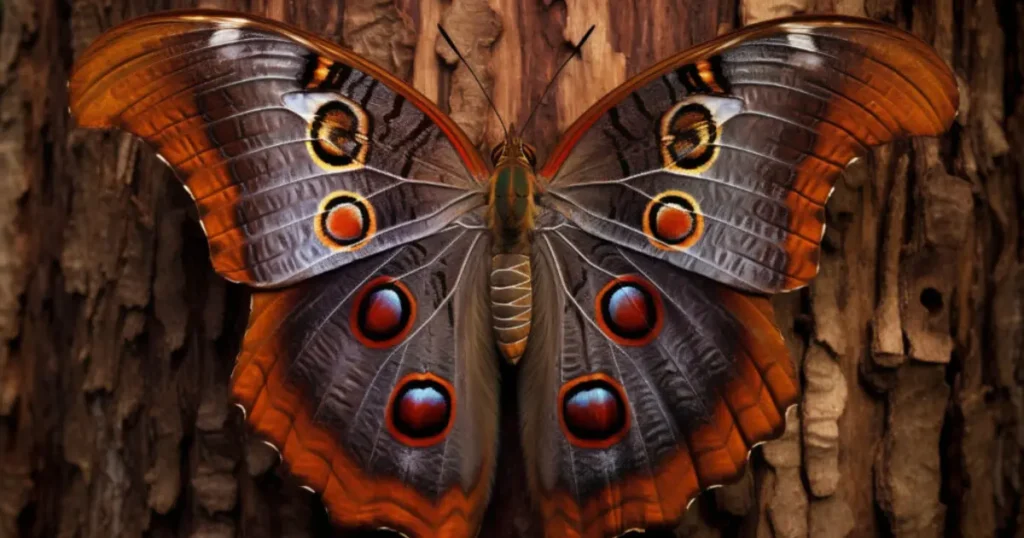Introduction
The Attacus atlas (Atlas Moth) is one of the largest and most remarkable insects in the world, with wings that can span up to 30 cm. Found in the tropical forests of Asia, its rust-red wings have bold patterns and tips shaped like a snake’s head to scare off predators.
Its life cycle is just as fascinating from a hungry caterpillar to an adult moth that doesn’t eat at all, every stage of the Atlas moth’s life highlights the wonder of nature.
Eggs
Atlas moths lay tiny round eggs on the underside of leaves, giving their caterpillars a safe place to hatch and feed.
Larva
After about two weeks, soft green caterpillars emerge and nibble on their eggshells before moving on to leaves from trees like citrus, guava, and cinnamon. As they grow, they can reach around 11 cm long and develop white, waxy spines along their backs, with a distinctive green-and-orange spot near the end of their bodies.
Key Specifications of Attacus atlas (Atlas Moth)
| Specification | Details |
| Scientific Name | Attacus atlas |
| Common Name | Atlas Moth (Attacus atlas) |
| Family | Saturniidae |
| Wingspan | Up to 25–30 cm (9.8–12 inches) — among the world’s largest moths |
| Appearance | Rust-red wings with white, black, and pink patterns; wingtips resemble a snake’s head |
| Habitat | Tropical and subtropical forests of Southeast Asia (India, Malaysia, Indonesia, Philippines) |
| Diet (Adult) | None — adults do not eat; survive on stored larval energy |
| Larval Food Plants | Citrus, guava, cinnamon, and evergreen trees |
| Lifespan | Adult: 1–2 weeks; Egg-to-adult cycle: ~6–8 weeks |
| Behaviour | Nocturnal; strong fliers despite large size |
| Conservation Status | Not globally endangered; vulnerable to deforestation and habitat loss |
Habitat and range
The Attacus atlas (Atlas Moth) is native to Southeast Asia, including India, Sri Lanka, Malaysia, Indonesia, and the Philippines. It thrives in tropical and subtropical forests where host plants are abundant. Some populations are also found in southern China and Taiwan, where warm climates support multiple breeding cycles per year.
Life cycle and reproduction
The life of the Atlas Moth (Attacus atlas) is as dramatic as its size:
- Egg Stage – Eggs are laid on the underside of leaves and hatch within 10–14 days.
- Caterpillar Stage – The caterpillar feeds intensively on host plants such as citrus and guava for about 4 weeks, storing energy for its brief adult life.
- Cocoon/Pupa Stage – The caterpillar spins a silk cocoon, entering a pupal stage that lasts around 4 weeks.
- Adult Stage – Emerging as a magnificent moth, the Atlas Moth (Attacus atlas) lives only 1–2 weeks, focused solely on reproduction.
Remarkably, adult moths lack functional mouthparts and never eat; they rely entirely on fat reserves accumulated as larvae.
Unique features
The Attacus atlas (Atlas Moth) is known for more than size. The wing tips resemble a snake’s head, complete with scale-like markings and curved shapes, which help scare off predators such as birds and lizards. Their rich brown, orange, and cream patterns provide camouflage among dry leaves and tree bark.
Ecological role & importance
As caterpillars, the Attacus atlas (Atlas Moth) contributes to plant pruning and nutrient recycling. As adults, they serve as food for birds and bats, supporting ecosystem balance. In some regions, their silk called “fagara” or “eri” is used for weaving durable textiles.
Conservation & threats
While the Attacus atlas (Atlas Moth) is not globally endangered, habitat loss from deforestation and urban development is a growing concern. Protecting tropical forests and encouraging sustainable silk production are key to safeguarding this species.
Frequently asked questions
Q1. How big is the Attacus atlas?
The Attacus atlas (Atlas Moth) has one of the world’s largest wingspans, reaching 25–30 cm (9.8–12 inches).
Q2. Are Atlas moths poisonous?
No. Atlas moths have no poison in it.
Q3. Is Attacus atlas a butterfly or a moth?
Attacus atlas is a moth.
Q4. Why do its wingtips look like a snake?
The wingtips of the Atlas Moth (Attacus atlas) mimic a snake’s head to deter predators.
Q5. Is the Atlas Moth endangered?
Not globally, but deforestation and habitat destruction threaten some local populations of the Atlas Moth (Attacus atlas).







